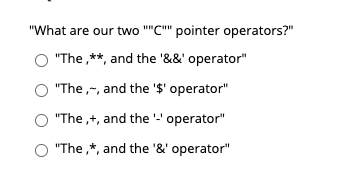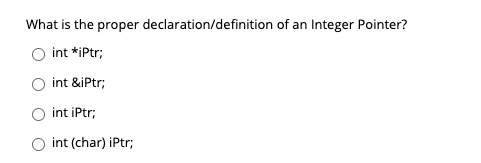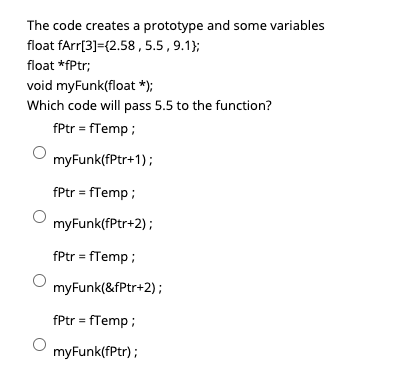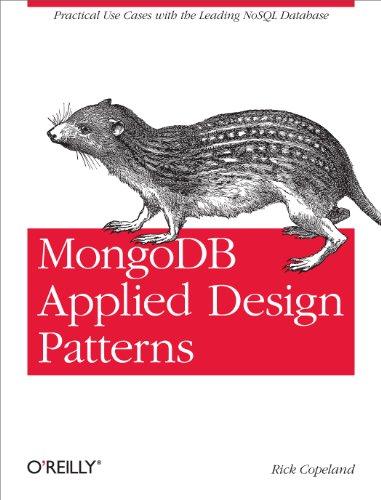









Why is a good idea to include Function prototypes in your Arduino program? Because your Arduino program will not run without them. A function prototype allows the compiler to run a more thorough syntax and structural evaluation of your program The prototype informs the reader of the program that there are unique funtions after the main loop. There really is no good reason to include function prototypes as they can confuse the programmer Local Variables may be accessed anywhere in your arduino program. True False "With respect to our Arduino programming, what is a pointer?" An integer data value A data access function A memory address Advice given to those less knowledgeable "What are our two ""C"" pointer operators?" "The,**, and the '&&' operator" "The ,-, and the '$' operator" "The , +, and the '-operator" "The *, and the '&' operator" What is the proper declaration/definition of an Integer Pointer? O int *iPtr; int &iPtr; int iPtr; int(char) iPtr; "Given the integer variable ""iTemp'' and the integer pointer 'iPtr'', what is the proper expression for loading iPtr with iTemp's memory address?" iPtr = *iTemp; iPtr = & Temp: iPtr = iTemp: iPtr == SiTemp; "Given the integer variable ''Temp" and the integer pointer "iPtr"", what is the proper expression for loading iTemp with data pointed to by iPtr?" O iTemp = (int)iPtr; iTemp = iPt; OiTemp = *iPtr; O iTemp = &iPtr; The code creates a prototype and some variables float fArr[3]={2.58, 5.5, 9.1}; float *fPtr; void myFunk(float *); Which code will pass 5.5 to the function? fPtr = fTemp: myFunk(fPtr+1); fPtr = fTemp; myFunk(fPtr+2); fPtr = fTemp; myFunk(&fPtr+2); fPtr = fTemp; myFunk(fPtr); The function Func1 takes an float-type pointer as an argument vFunc1( float *); // This is how you create a function prototype for a function that will take a pointer to a floating point type variable How would you pass the normally created float variable fTemp to vFunc1? fTemp is NOT a pointer. vFunc1(fTemp); VFunc1(&fTemp); vFunc1(); fTemp OvFunc1( *fTemp*); What three types of memory are available to you on your arduino microcontroller board? "Optical, Dynamic and Static" "Eprom, SRAM and PAL" "Flash, SRAM and Eeprom" "Flash, DRAM and Core
















